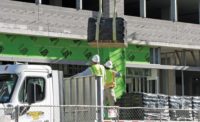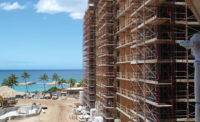The Air Tight Fight






A tight building envelope is increasingly getting the recognition it deserves for its energy efficiency contribution. In many cases, this recognition is coming in the form of increasingly stringent regulations and code specifications, signaling that both the government and the industry are more aware of the energy wasted through air leakage via leaky building envelopes.
While building high performance buildings requires some change, it’s not as difficult as one might think. High quality mechanicals, smart control strategies and efficient lighting strategies are all key pieces to this puzzle, but energy efficiency really starts with the building envelope. Creating a tight building envelope requires a system-wide approach and the integration of air tightness, R value, construction types, aesthetics, total U value and continuous insulation as well.
In addition to the altruistic benefit of providing greater energy efficiency, a tight building envelope also produces increased comfort for homeowners, better indoor air quality and improved moisture management.
ENERGY EFFICIENCY AND COMFORT
According to the Department of Energy, uncontrolled air leakage can account for as much as 30 to 50 percent of a building’s heating and cooling costs. The reason is simple: every bit of outside air that enters the building through air infiltration must then be heated, cooled, and/or dehumidified to get back to a thermostat’s set point.
According to studies performed by Lawrence Berkeley National Laboratory, in a typical existing American home, the entire volume of air within the home is exchanged with air from the outside every one to two hours on average. If the thermometer reads 10 degrees Fahrenheit outside, leaky buildings are not only uncomfortable, but very expensive.
INDOOR AIR QUALITY
When discussing tight building envelopes, the most common concern is that building occupants need “fresh air.” While it is true that fresh air is necessary for maintaining a healthy, comfortable space, modern ventilation strategies are changing the misconception that a tight building is bad for indoor air quality.
With tight buildings, ventilation must be controlled mechanically. Rather than allowing “fresh air” to enter randomly whenever the wind blows through whatever cracks and gaps are available, air is brought in from outside, passed through a filter, pre-conditioned, and then delivered anywhere within the building.
A tight building envelope also reduces allergens by keeping out pollen and sealing occupied spaces off from areas like garages, where people can be exposed to fumes from cars, paints or household cleaners.
MOISTURE MANAGEMENT
Managing moisture is the key to mitigating mold concerns. Air leakage is a very fast process and presents a high potential for condensation, mold and rot. Moisture can enter as hot, humid air infiltrating on a hot New Orleans summer day, only to condense on the cold back surface of the interior gypsum board. Alternatively, it could be warm, 50 percent relative humidity air leaving a heated New England home on a winter day to condense on the cold back surface of the exterior sheathing. Air barrier materials and tight buildings are the first line of defense against moisture problems.
ACHIEVING A TIGHT ENVELOPE
The benefits of a tight building envelope are clear—but how are they achieved? Building tight buildings is about more than just using air barrier materials. After all, everyone builds with gypsum board, the very definition of an air barrier material, and yet very few buildings are truly “tight.” It’s the transitions, connections and penetrations that determine air tightness. The ceiling and attic, parapet wall transition, cantilevered floor, crawl space, rim and band joists, windows and doors are what most often leak.
There are multiple material options to achieve an air tight structure. Cladding choices, substrates, vapor permeance requirements and overall wall assembly design (including insulation), all play a role in the choice of the air barrier. Closed cell spray polyurethane foam on the exterior of a building can provide the air barrier, vapor retarder, weather resistive barrier, and continuous insulation with a robust ability to meet air tightness objectives. Both open cell and closed cell SPF can be used inside cavity walls to achieve tight construction, as well. Fluid-applied air barriers are versatile products that are available as either vapor permeable or impermeable while performing the weather resistive barrier function. “Peel and stick” or self-adhered products and commercial building wraps can also serve as air barrier and weather-resistive barriers but require more attention to detail to be installed properly.
Regardless of material selection, there are some concepts to keep in mind:
-
The air barrier should be continuous around the entire building envelope. If you have to lift the pencil when tracing it, it’s not continuous.
-
The air barrier material selection needs to make sense for the cladding type, drainage plane requirements, substrate and climate.
-
Transition membranes and flashings are critical to performance.
-
Air barrier transitions need to be detailed in the drawings per manufacturer’s recommendations.
-
Workmanship and attention to detail are key for any air barrier installation but some systems are more robust than others.
-
The individual responsible for the air tightness performance of the building must be defined.
-
Checks must be made to ensure the trade responsible has the required training and experience.
-
A quality assurance program like the Air Barrier Association of America should be utilized to ensure proper field installation.
-
The building should be inspected and tested.
MECHANICAL CONSIDERATIONS
The modern ventilation strategies that help a tight building maintain an optimum level of health for its owners require that the design of the mechanical systems be matched with the performance of the building envelope. With the energy reduction that tight buildings provide, HVAC systems can be significantly downsized, saving upfront costs.
Key considerations are:
-
Ventilation rates and strategy, as “fresh air” is no longer supplied through the gaps and cracks in the building.
-
Use of sealed combustion or power-vented combustion equipment to prevent flue gas spillage and back-drafting.
-
Detailed sizing analysis (Manual J) to achieve a right-sized HVAC system that minimizes upfront and operating costs, does not short cycle and ensures comfort.
-
Proper system design and equipment selection to ensure humidity control for comfort.
-
Good duct design to ensure sufficient air mixing and distribution.
With the materials, assemblies and techniques available today, creating a tight building envelope is easily achievable. From there, adjusting ventilation strategies ensures that the home is healthy, and that the energy efficiency achieved provides the most lasting value to home owners. Proactively adopting these new methods helps builders and contractors differentiate themselves from competitors and stay ahead of increasingly stringent code changes.
Looking for a reprint of this article?
From high-res PDFs to custom plaques, order your copy today!








